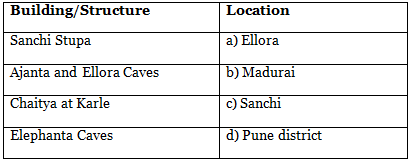Worksheet Solutions: Culture and Science | Footprints Class 6: Book Solutions, Notes & Worksheets PDF Download
Q1: Multiple Choice Questions (MCQs)
(i) What is the central theme of the Ramayana?
(a) The life of Buddha
(b) The struggle between Kauravas and Pandavas
(c) The story of Lord Rama and Sita
(d) Tales of previous lives of Buddha
Ans: (c)
The Ramayana revolves around the lives of Lord Rama, his wife Sita, and their many travails.
(ii) Who is the author of Silapaddikaram?
(a) Ved Vyas
(b) Ilango Adigal
(c) Kalidasa
(d) Sattanar
Ans: (b)
Silapaddikaram was composed by Ilango Adigal around 1,800 years ago.
(iii) Which of the following is NOT a Purana mentioned in the text?
(a) Vishnu Purana
(b) Vayu Purana
(c) Matsya Purana
(d) Panchatantra
Ans: (d)
The Puranas mentioned in the text are Vishnu Purana, Vayu Purana, and Matsya Purana.
(iv) What is the moral purpose of the Panchatantra stories?
(a) Historical accounts
(b) Entertainment only
(c) Moral lessons
(d) Religious rituals
Ans: (c)
The Panchatantra contains tales with morals attached to each story.
(v) Who is considered the greatest poet and dramatist of classical Sanskrit in the text?
(a) Valmiki
(b) Ilango Adigal
(c) Ved Vyas
(d) Kalidasa
Ans: (d)
Kalidasa, living in the court of Chandragupta II, is revered as the greatest poet and dramatist of classical Sanskrit.
Q2: Fill in the Blanks
(i) Aryabhata explained that days and nights were caused by the ____________ of the Earth on its axis.
Ans: rotation
(ii) Varahamihira stated that the Moon rotates around the ____________ and the Earth around the ____________.
Ans: Earth, Sun
(iii) In the field of mathematics, ancient Indians contributed the notational system, the decimal system, and the concept of ____________.
Ans: zero
(iv) What is the most famous work of Varahamihira mentioned in the text?
Ans: Brihat-Samhita
(v) The three greatest contributions of ancient Indians in mathematics include the notational system, the decimal system, and the concept of ____________.
Ans: zero
Q3: Match the Column (In a Table)
 Ans:
Ans:
Q4: True/False
(i) The Ramayana and Mahabharata are the two greatest epics of Indian literature.
Ans: True
(ii) The Puranas were composed in Tamil and compiled around the 4th century CE.
Ans: False
The Puranas were composed in Sanskrit.
(iii) Aryabhata developed a scientific explanation for eclipses.
Ans: True
(iv) The stupa at Sanchi was originally built by the Sunga empire.
Ans: False
The original stupa was built by Ashoka, and later repaired and expanded by the Sunga empire.
|
65 videos|127 docs|25 tests
|
FAQs on Worksheet Solutions: Culture and Science - Footprints Class 6: Book Solutions, Notes & Worksheets
| 1. What is the significance of culture in society? |  |
| 2. How does culture impact scientific advancements? |  |
| 3. What are some examples of how culture and science intersect? |  |
| 4. How does culture influence the perception of scientific facts? |  |
| 5. What are the challenges faced in integrating culture and science? |  |















